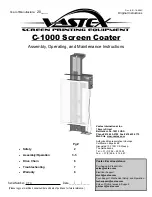
EN-40
Troubleshooting (continued)
No image appears on the screen. (continued)
Problem
Solution
The screen for
entering the password
appears.
• PASSWORD FUNCTION in the FEATURE menu has been set to DISPLAY INPUT to
enable the password lock.
Enter the password or contact the person in charge of management of the
projector. (See page 34.)
“NO SIGNAL” is
displayed.
• Turn on the power of the connected device, or check whether there is something
wrong with the connected device.
• Check whether the external device output signals. (Check this especially when the
external device is a notebook computer.)
• Check that the cable connected to the external device isn’t defective.
• Check that the projector is connected to the external device using the correct
terminals.
• Check that the connected device is correctly selected as the input source.
• When an extension cord is being used, replace it with the supplied cable and check
whether images are projected correctly. If images are projected correctly, use an RGB
signal amplifier along with the extension cord.
Images are not displayed correctly.
Problem
Solution
Projected images are
shaking.
Projected images are
displaced.
• Check that the cable connected to the external device isn’t intermittent.
• Connect the cable’s plug with the external device’s connector firmly.
• Press the AUTO POSITION button.
• Some computers output out-of-spec signals on rare occasion. Adjust the SIGNAL
menu. (See page 29.)
Projected images are
distorted.
• Adjust the projector and the screen so that they are perpendicular to each other. (See
page 14.)
Projected images are
dark.
• Adjust BRIGHTNESS and CONTRAST in the QUICK MENU or the IMAGE menu. (See
page 27.)
• Replace the lamp. (See page 37.)
Projected images are
blurred.
• Adjust the focus. (See page 16.)
• Clean the lens.
• Press the
or
button on the remote control to eliminate flicker.
• Adjust TRACKING and FINE SYNC. in the SIGNAL menu. (See page 29.)
• Adjust BRIGHTNESS and CONTRAST in the QUICK MENU or the IMAGE menu. (See
page 27.)
• Adjust the projector and the screen so that they are perpendicular to each other. (See
page 14.)
Afterimages persist on
the screen.
•
This phenomenon is improved by keeping projecting an evenly bright image. (Such
“image burn-in” phenomenon where afterimages persist on the screen may occur if a
stationary image is kept displayed on the screen for a long time.)
White dots are seen
on projected images.
Black dots are seen
on projected images.
• This phenomenon is normal for a DLP™ projector and is not a malfunction. (A very
small number of pixels may visibly or invisibly be persistent all the time, but they are
not a sign of system malfunctions. Over 99.99% of the pixels are effective.)
Fine streaks are seen
on projected images.
• This is due to interference with the screen surface and is not a malfunction. Replace
the screen or displace the focus a little.
• Vertical or horizontal streak noise may appear on the projected image, depending on
the type of the DVD player, game console or computer you use. In such a case, you
can reduce such streak noise by enabling the LPF.
Projected images
become wavy.
• Connect the plugs of the cables to external devices securely.
• Keep the projector away from equipment generating interfering radio waves.
• When the keystone adjustment is carried out, the image may not be displayed
correctly because of the type of input signal. This isn’t a product malfunction. In this
case, readjust the keystone so that the amount of keystone correction is as small as
possible.









































